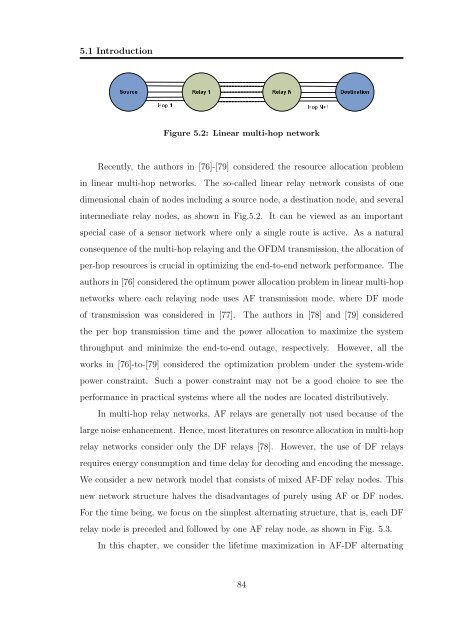Resource Allocation in OFDM Based Wireless Relay Networks ...
Resource Allocation in OFDM Based Wireless Relay Networks ...
Resource Allocation in OFDM Based Wireless Relay Networks ...
Create successful ePaper yourself
Turn your PDF publications into a flip-book with our unique Google optimized e-Paper software.
5.1 Introduction<br />
Figure 5.2: L<strong>in</strong>ear multi-hop network<br />
Recently, the authors <strong>in</strong> [76]-[79] considered the resource allocation problem<br />
<strong>in</strong> l<strong>in</strong>ear multi-hop networks. The so-called l<strong>in</strong>ear relay network consists of one<br />
dimensional cha<strong>in</strong> of nodes <strong>in</strong>clud<strong>in</strong>g a source node, a dest<strong>in</strong>ation node, and several<br />
<strong>in</strong>termediate relay nodes, as shown <strong>in</strong> Fig.5.2. It can be viewed as an important<br />
special case of a sensor network where only a s<strong>in</strong>gle route is active. As a natural<br />
consequence of the multi-hop relay<strong>in</strong>g and the <strong>OFDM</strong> transmission, the allocation of<br />
per-hop resources is crucial <strong>in</strong> optimiz<strong>in</strong>g the end-to-end network performance. The<br />
authors <strong>in</strong> [76] considered the optimum power allocation problem <strong>in</strong> l<strong>in</strong>ear multi-hop<br />
networks where each relay<strong>in</strong>g node uses AF transmission mode, where DF mode<br />
of transmission was considered <strong>in</strong> [77]. The authors <strong>in</strong> [78] and [79] considered<br />
the per hop transmission time and the power allocation to maximize the system<br />
throughput and m<strong>in</strong>imize the end-to-end outage, respectively. However, all the<br />
works <strong>in</strong> [76]-to-[79] considered the optimization problem under the system-wide<br />
power constra<strong>in</strong>t. Such a power constra<strong>in</strong>t may not be a good choice to see the<br />
performance <strong>in</strong> practical systems where all the nodes are located distributively.<br />
In multi-hop relay networks, AF relays are generally not used because of the<br />
large noise enhancement. Hence, most literatures on resource allocation <strong>in</strong> multi-hop<br />
relay networks consider only the DF relays [78]. However, the use of DF relays<br />
requires energy consumption and time delay for decod<strong>in</strong>g and encod<strong>in</strong>g the message.<br />
We consider a new network model that consists of mixed AF-DF relay nodes. This<br />
new network structure halves the disadvantages of purely us<strong>in</strong>g AF or DF nodes.<br />
For the time be<strong>in</strong>g, we focus on the simplest alternat<strong>in</strong>g structure, that is, each DF<br />
relay node is preceded and followed by one AF relay node, as shown <strong>in</strong> Fig. 5.3.<br />
In this chapter, we consider the lifetime maximization <strong>in</strong> AF-DF alternat<strong>in</strong>g<br />
84

















